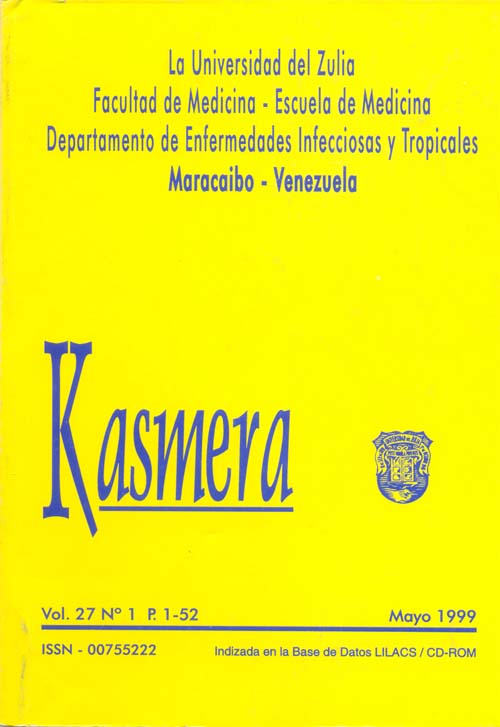Métodos de aglutinación con partículas de látex y Rantz- Randall para el diagnóstico de las infecciones estreptococias
Abstract
En el presente trabajo se compararon los métodos de aglutinación con panículas de látex (AL) y Rantz-Randall (R.R.) para investigar anticuerpos antiestreptolisina ";O"; en 72 muestras de sueros sanguíneos. Este estudio reveló un mayor porcentaje de positividad, por el método R.R. (55,5%) que por AL (16,6%). Cuando evaluamos la discordancia en nuestros datos, se observa que un suero positivo por AL (título 400 Ul/ml) fue negativo para R.R., lo cual pudo ser un falso positivo por la presencia de anticuerpos inespecíficos. En el caso de las 19 muestras de suero que resultaron positivas por R.R. a diluciones superiores a 1:240 y negativas por AL, podría explicarse por la mayor sensibilidad de la primera técnica y/o la presencia de falsos negativos por la técnica de AL, debido al fenómeno de prozona. El análisis estadístico mediante el Chi cuadrado, determinó que entre los métodos de R.R. y AL, hubo diferencia significante, lo cual reveló la importancia de este estudio, ya que demuestra que el método de R.R. constituye una alternativa superior al de AL, como complemento del diagóstico clínico y bacteriológico de las infecciones estreptocócicas.
Copyright (c) 2009 E Pozo de N, Romero T, A Ruiz, R Hidalgo, S Quintero, C Vivas

This work is licensed under a Creative Commons Attribution-NonCommercial-ShareAlike 4.0 International License.
Kasmera journal is registered under a Creative Commons an Attribution-NonCommercial-ShareAlike 4.0 International (CC BY-NC-SA 4.0), available at: https://creativecommons.org/licenses/by-nc-sa/4.0/deed.en; which guarantees the freedom to share-copy and redistribute the material in any medium or format and adapt-remix, transform and build from the material, provided that the name of the authors, the Department of Infectious and Tropical Diseases, Zulia´s University and Kasmera Journal, you must also provide a link to the original document and indicate if changes have been made.
The Department of Infectious and Tropical Diseases, University of Zulia and Kasmera Journal do not retain the rights to published manuscript and the contents are the sole responsibility of the authors, who retain their moral, intellectual, privacy and publicity rights. The guarantee on the intervention of the manuscript (revision, correction of style, translation, layout) and its subsequent dissemination is granted through a license of use and not through a transfer of rights, which represents the Kasmera Journal and Department Infectious Diseases, University of Zulia are exempt from any liability that may arise from ethical misconduct by the authors.
Kasmera is considered a green SHERPA/RoMEO journal, that is, it allows self-archiving of both the pre-print (draft of a manuscript) and the post-print (the corrected and peer-reviewed version) and even the final version (layout as it will be published in the journal) both in personal repositories and in institutional and databases.











_pequeño1.png)

_pequeña.png)









_pequeña.png)




_pequeña.jpg)






